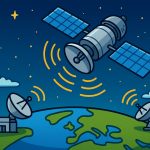On October 4, 1957, the world changed forever when the Soviet Union launched Sputnik 1, the first artificial satellite to orbit Earth. This moment marked the beginning of the space age and triggered the space race between the USSR and the USA. Sputnik’s launch was not only a technological milestone but also a symbol of geopolitical power during the Cold War era. But how exactly was this tiny satellite launched into space — and why was it such a monumental achievement?
What Was Sputnik 1?
Sputnik 1 (which means “companion” or “satellite” in Russian) was a metal sphere about 58 centimeters in diameter, weighing 83.6 kilograms. It had four long antennas to transmit radio pulses. Despite its simple design, Sputnik 1 could send signals back to Earth that were detectable by radio operators worldwide.
It didn’t carry scientific instruments or cameras — its main purpose was to prove that launching an artificial satellite was possible.
How Sputnik Was Launched
The launch vehicle for Sputnik was a modified R-7 intercontinental ballistic missile (ICBM) — originally built to deliver nuclear warheads. Engineers repurposed it into a space launch rocket. Here’s how the launch worked:
- The R-7 was placed on a launchpad at the Baikonur Cosmodrome in Kazakhstan.
- The rocket used liquid fuel and had two stages to reach orbital speed.
- At launch, the rocket burned for about 5 minutes, accelerating Sputnik to a speed of 28,000 km/h.
- Once in orbit, Sputnik separated from the rocket and began circling Earth every 96 minutes.
This achievement shocked the world — no one expected the Soviets to succeed before the Americans.
The Political and Scientific Impact
Sputnik’s launch had immediate and dramatic effects:
- It demonstrated Soviet space superiority, surprising U.S. scientists and military leaders.
- It sparked the creation of NASA in 1958.
- It intensified investment in science, education, and technology in the U.S. and worldwide.
- It was the beginning of space exploration as a global priority.
Sputnik transmitted beeping radio signals that lasted 21 days, after which its batteries died. The satellite remained in orbit for three months, until it burned up in Earth’s atmosphere in January 1958.
How Sputnik Was Built
Sputnik 1 was designed under the direction of Sergey Korolev, the chief Soviet rocket engineer. The satellite had:
- A polished aluminum-magnesium sphere to reduce resistance in space.
- Four external antennas, each over 2 meters long.
- Two radio transmitters sending beeps at 20.005 and 40.002 MHz.
- Internal pressurization to keep equipment stable in vacuum.
The design focused on simplicity and reliability, prioritizing a successful launch over collecting complex data.
Legacy of Sputnik
The launch of Sputnik 1 set in motion a chain of historic events:
- The launch of Sputnik 2 just one month later, carrying the dog Laika — the first animal in orbit.
- The eventual human spaceflight of Yuri Gagarin in 1961.
- The drive toward Moon landings, space stations, and later, Mars exploration.
Sputnik became a symbol of scientific progress and remains a landmark in the history of space technology.
Glossary
- Sputnik 1: The first artificial satellite launched into orbit by the USSR in 1957.
- Baikonur Cosmodrome: The Soviet (and now Russian) space launch site in Kazakhstan.
- R-7 rocket: The launch vehicle used to place Sputnik into orbit.
- Orbit: The curved path a satellite follows around a planet.
- ICBM: Intercontinental Ballistic Missile, originally designed for military use.
- Sergey Korolev: Chief designer of the Soviet space program.


